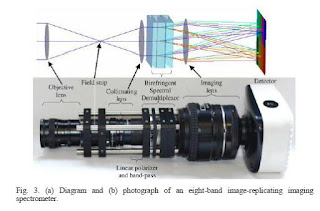Bob Sturm kindly responded to my taunt in Paper of the Day (Po'D): Compressed Sensing and Coherent Dictionaries Edition. This entry points to his first Paper of the Day entry which point to this paper On Compressed Sensing and Its Application to Speech and Audio Signals by Mads Christensen, Jan Østergaard, and Søren Holdt Jensen. The paper ends with this last sentence
Thanks Bob.
My take from this is: In an engineering field where sensors can already acquire signals with high frequency and fidelity, for a compressive microphone to exist would require a niche market that the current microphones are not answering. What would that niche market be ?
This basically means that sparse decompositions with compressed sensing works no worse than sparse decompositions did in the first place
Thanks Bob.
* Alex Gittens has a question on Group sparsification.
* Gonzalo Vazquez-Vilar does a Quick survey on wideband spectrum sensing for CR.
* The following blog might look like one of those spam ridden honeypots filling the interwebs but in fact it is not. It is a genuine source of information on imaging sensors and I learn from it every time I check it out. Here is the address:
Of interest this time is this entry:
What the different between Back Side Illumination (BSI) and Front Side Illumination (FSI) (from here)

In the entry, one can read this explanation of the underlying technology:

The description of the lightguides, made me think of the Anger Coding Scheme as mentioned in one of the Technologies that do not Exist (the series is here). Maybe I should be coming back to that later.
I initially came to that site from David Brady's blog who released the following entries in April:
I initially came to that site from David Brady's blog who released the following entries in April:
- The principles and methods of geometrical optics
- Liquid crystal lens technology
- hand held Raman scanners
- snapshot spectral imaging: the paper featured there is that of a compressive imager that seems to perform an analog reconstruction:

Generalization of the Lyot filter and its application to snapshot spectral imaging by Alistair Gorman, David William Fletcher-Holmes, and Andrew Robert Harvey. The abstract reads:
A snapshot multi-spectral imaging technique is described which employs multiple cascaded birefringent interferometers to simultaneously spectrally filter and demultiplex multiple spectral images onto a single detector array. Spectral images are recorded directly without the need for inversion and without rejection of light and so the technique offers the potential for high signal-to-noise ratio. An example of an eight-band multi-spectral movie sequence is presented; we believe this is the first such demonstration of a technique able to record multi-spectral movie sequences without the need for computer reconstruction.
Obviously, the fact that there is no need for computer reconstruction makes this system not a compressive imager the way we usually define it and the question then becomes: Can additional mixing be undertaken with the same system so that a computer reconstruction is needed. In that case, how much does such an approach bring in terms of performance ?
2 comments:
Quoting:
" My take from this is: In an engineering field where sensors can already acquire signals with high frequency and fidelity, for a compressive microphone to exist would require a niche market that the current microphones are not answering. What would that niche market be ?"
Easy: any medical device that requires medical intervention to change the batteries (would be one niche market).
That is, any device that requires micro power, could potentially be made a lower power device by using sparse sampling (lower sampling rates).
If the power required for the DSP to identify replacement tokens (for the signal being processed) using a lower sample rate than the nyquist criterion) is lower than the power needed at a sample rate at or greater than the nyquist criterion;
Then compressed sensing for an acoustic (or any other) medical device would give an advantage of lower power consumption.
And hence this would create a niche market.
The comment I left for niche devices also applies for devices that use trans-cutaneous power delivery since this is a pretty lossy mode of power delivery.
Medical Transcutaneous devices are usually powered via batteries. So any saving in power that can be made will also be advantageous.
"Compressed Sensed Transcutaneous Power Delivery"
Post a Comment